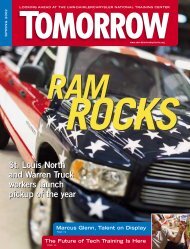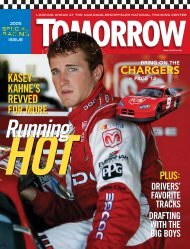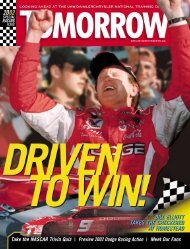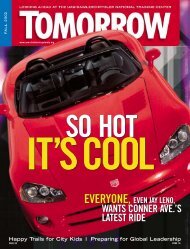Create successful ePaper yourself
Turn your PDF publications into a flip-book with our unique Google optimized e-Paper software.
“Now, the muscle Charger is <strong>com</strong>ing<br />
back. It just makes sense to get back to<br />
our heritage and bring the Charger<br />
back to NASCAR.”<br />
A HERITAGE<br />
OF EXCELLENCE<br />
In the showroom, Dodge fans can get<br />
an SRT8 version of the Charger that<br />
takes the optional 5.7-liter Hemi and<br />
upgrades it to a 6.1. Then there are<br />
great wheels, tires, wings and other<br />
options Dodge owners love. “They get<br />
a car that reflects the muscle that’s on<br />
the track,” says Fernandez. “It’s a real<br />
performance machine.”<br />
On the track, Chargers remain true<br />
to their racing roots — but with a whole<br />
new world of technological precision.<br />
“<strong>Racing</strong> engineering has <strong>com</strong>e a long<br />
way, and the Chargers reflect that,”<br />
Fernandez says. “They pack more pure<br />
speed, with incredible aerodynamics<br />
and the development of chassis and tire<br />
sophistication.”<br />
Of course, Buddy Baker knows all<br />
about the fast part. His speed record of<br />
200.447 mph at Talladega on March 24,<br />
1970, ignited unprecedented buzz about<br />
the Dodge Charger. It remains a milestone<br />
in NASCAR history. “One of the<br />
first laps was 199.8 mph,” says Baker.<br />
“And that was just warming up.”<br />
The record-breaking No. 88 had<br />
modest beginnings. It began as a loaner<br />
vehicle, available to journalists looking<br />
CONTINUED ON PAGE 16<br />
Ralph Gilles, lead designer<br />
for the <strong>2006</strong> Charger.<br />
Ralph Gilles is a lot like the cars he<br />
creates — confident, daring and a bit<br />
risqué. As lead designer for the <strong>2006</strong><br />
Dodge Charger, he dusted off a racing<br />
gem with a legendary NASCAR past<br />
that has everybody talking — on and off<br />
the racetrack.<br />
“Design has to be polarizing,” says<br />
Gilles. “To <strong>com</strong>e up with vanilla is<br />
generic. But controversy, well executed,<br />
can work in your favor.”<br />
The 35-year-old Canadian-born<br />
designer has been polishing the<br />
<strong>Chrysler</strong> Group’s power image since<br />
his arrival in 1992. Credited with<br />
also leading the design on the Dodge<br />
Magnum and the <strong>Chrysler</strong> 300<br />
sedan, the wunderkind of Studio 3 at<br />
the Daimler<strong>Chrysler</strong> Technology<br />
Center is fearless in making creative<br />
statements.<br />
Gilles boasts that the design of the<br />
Charger is full of character and flavor —<br />
with an in-your-face attitude that only<br />
an American car can get away with.<br />
He’s referring to the distinguishing<br />
features like the “fender kick-up” at<br />
the side windows, the bold rear-fender<br />
detail and the furrow-browed front<br />
nose that accents the Charger’s<br />
aggressive posture.<br />
“We asked ourselves, ‘Are the lights<br />
too angry’? If we get un<strong>com</strong>fortable<br />
during design, that’s a good thing,” he<br />
says. “But that’s why I love<br />
this job, because we don’t<br />
shy away from risk-taking.”<br />
Sketching over old cars<br />
as a kid, Gilles had visions<br />
of future greatness. His<br />
parents were concerned<br />
that he spent too much time<br />
drawing and not enough<br />
thinking about a “real”<br />
career. But even while living<br />
in his parent’s basement<br />
with no job, Gilles was<br />
DESIGNER SETS<br />
FAST PACE<br />
set on designing <strong>Chrysler</strong> cars.<br />
“I fell in love with the Viper,” he says.<br />
“I saw this <strong>com</strong>pany <strong>com</strong>mitting a lot of<br />
capital to a new building and a new<br />
image, and I knew that design was still<br />
a very powerful tool for this <strong>com</strong>pany.”<br />
After graduating from Detroit’s<br />
College for Creative Studies, Gilles<br />
landed his dream job at <strong>Chrysler</strong> and<br />
watched his stock skyrocket as he<br />
became one of the top designers in the<br />
auto industry.<br />
Gilles’ achievements as an African<br />
American in a field dominated by white<br />
designers are noteworthy, but he<br />
downplays race as a barrier to his<br />
success. He prefers to let his track<br />
record speak for itself.<br />
“The doors aren’t closed to African<br />
American designers,” says Gilles. “It’s<br />
just the consciousness is not there.<br />
Sometimes it does help (being an<br />
African American). It makes people<br />
listen differently mainly because<br />
they’re intrigued. In hindsight, it has<br />
been more of a benefit.”<br />
Despite the kudos Gilles has gained<br />
for his three prize vehicles, he is quick<br />
to point to the <strong>com</strong>bined efforts of his<br />
team of designers and engineers.<br />
“I’m just one member of a really<br />
great team. In high school, it was easy<br />
being the best. You <strong>com</strong>e here, and<br />
everybody’s good.”<br />
Currently, Gilles is settling in to a<br />
new challenge — truck design. His<br />
latest creation is under a tight lid, but<br />
judging by his Charger credentials,<br />
NASCAR’s Craftsman Truck Series<br />
better watch out. A new racing icon<br />
might be waiting in the wings.<br />
— Tanisha Perez<br />
Read more about Ralph Gilles on<br />
the <strong>UAW</strong>-Daimler<strong>Chrysler</strong> NTC<br />
Web site at www.uawdcx.<strong>com</strong>/<br />
publications/tomorrow.cfm.<br />
TOMORROW SPECIAL RACING <strong>2006</strong> 15

















